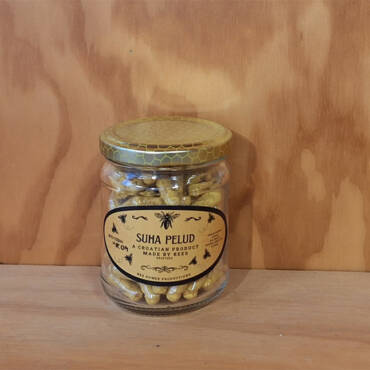Beeswax
Beeswax: natural treasure of the beehive
Beeswax is not just peripheral by-product of beekeeping, it is a valuable natural treasure with many possiblities for application. This yellow substance produced by the worker bees, as you might know it, is used as a foundation building block in the bee kingdom, but also as a valuable material for many applications in the industry and the household.
Builder bees:
Builder bees produce beeswax from special glands on their bellies. They use this wax to build the honeycomb, their home and the centre of life in the beehive. Honeycomb consists of hexagonal cells, which bees use for storing honey and pollen, raising new generations of bees and protecting the queen.
Composition and properties:
Beeswax is a mixture of different natural compounds, including carbohydrates, esters and fatty alcohols. It has a characteristic yellow color, pleasant scent of honey and propolis, and it is not soluble in water and some acids.
How to use beeswax:
Beeswax can be used for different purposes, from traditional to modern ones. Here are some examples:
- Candles: Traditionally, the most famous use of beeswax is candle making. Candles made of beeswax, due to their melting point and composition, burn longer than paraffin ones and emit a natural and pleasant smell when burning.
- Cosmetics: Beeswax is, as honey, one of the essential components of our Bee Kiss lip balms, body lotions and creams for face and body. Its moisture and ability to create a protective layer make it ideal for nourishing your skin.
- Food industry: Beeswax is used as a food additive (E901) for glazing fruit, syrup and candy. It is also used for packaging and protection of food. Our beeswax products for restoring old furniture, for horticulture and winemaking have found a way to our customers and became indispensable as such.
- Wood industry: We process beeswax so that it can be used for polishing wooden furniture and valuable musical instruments giving them a natural protection and shine.
- Art: Beeswax can be used for making parts of various figures, like chess pieces, and traditionally it was used for making seals.
Advantages of beeswax:
Beeswax has numerous advantages over synthetic alternatives:
- Natural: Beeswax is a completely natural product and it is safer for health then many synthetic products.
- Renewable: Bees continually produce beeswax, which makes it a renewable source.
- Biodegradable: Beeswax breaks down relatively quickly in natural conditions and it does not present a special burden on the environment, as paraffin does.
- High-quality: Beeswax has excellent physical and chemical properties, which makes it a durable product with long-lasting effects.
Beeswax in various languages:
English: Beeswax
French: Cire d’abeille
German: Bienenwachs
Spanish: Cera de abeja
Italian: Cera d’api
Portuguese: Cera de abelha
Russian: Пчелиный воск (Pcheliniy vosk)
Japanese: ミツロウ (Mitsurō)
Korean: 벌밀랍 (Beol millap)
Chinese: 蜂蜡 (Féng là)
Hindi: मधुमक्खी का मोम (Madhumakhī kā mom)
Arabian: شمع العسل (Shama’ al-ʿasal)
Hebrew: שעוות דבורים (Sha’avat devorim)
These are just some examples, and the names of beeswax can vary depending on the dialect or local variety of the language.
Additionally, there are specific names for beeswax of different colors and properties. For example, in English "white beeswax" is used for white beeswax, while "yellow beeswax" is used for yellow beeswax.
Conclusion:
Beeswax is more than just a nice yellow substance in the honeycomb. It is a valuable natural material with many practical applications. When choosing our beeswax products you will not only enjoy their qualities but support our beekeeping and sustainable access to natural resources.



